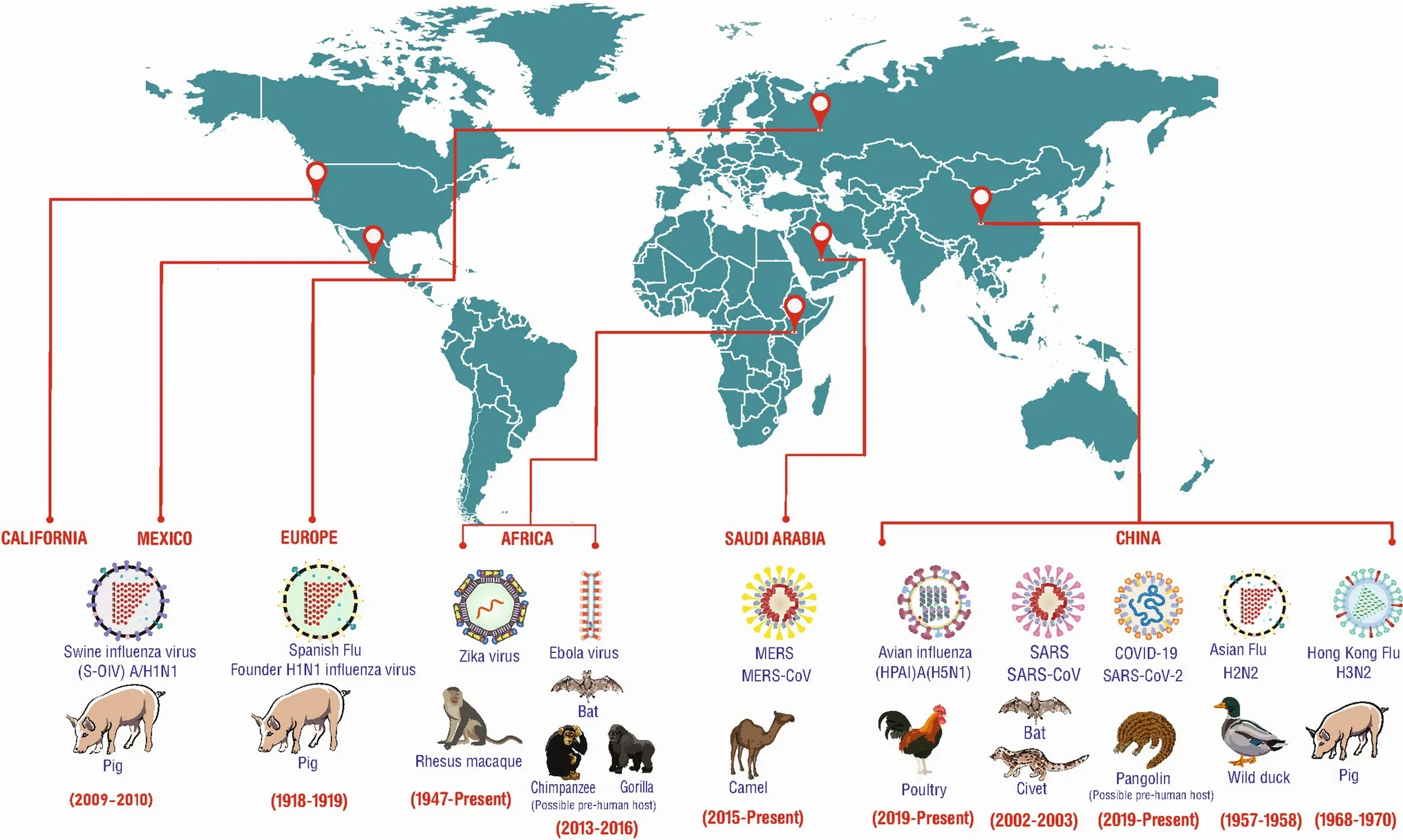Zoonotic Diseases | 11 Aug 2025
Why in News?
A recent study shows that over 9% of the Earth’s land faces high or very high risk of zoonotic diseases. It introduced an "epidemic risk index" that combines zoonotic risk with countries’ preparedness, helping policymakers identify vulnerable areas, improve response, allocate resources, and enhance global health cooperation.
What are Zoonotic Diseases?
- About: Zoonotic diseases (zoonoses) are infectious diseases transmitted between animals and humans.
- They can be caused by bacteria, viruses, parasites, and fungi, ranging from mild to life-threatening.
- Climate change (rising temperatures, shifting precipitation) and land-use changes (deforestation, urban expansion) increased human-animal interactions, escalating the risk of zoonotic spillovers.
- Eg: Rabies, anthrax, influenza (H1N1 and H5N1), Nipah, Covid-19, brucellosis, tuberculosis, Ebola and SARS
- They can be caused by bacteria, viruses, parasites, and fungi, ranging from mild to life-threatening.
- Disease Burden: Zoonotic diseases constitute 60% of known infectious diseases and up to 75% of emerging infectious diseases (EIDs), causing over 2.5 billion cases and 2.7 million deaths globally each year.
- Globally, 9.3% of land is at high (6.3%) or very high (3%) risk of zoonotic outbreaks, with 3% of the population in extremely high-risk zones and 20% in medium-risk areas.
- Latin America (27%), Oceania (18.6%), Asia (7%), and Africa (5%) have significant regional vulnerabilities.
- Modes of Transmission: Direct contact (avian influenza), food-borne (salmonella), vector-borne (West Nile virus), and water-borne (Cryptosporidiosis) routes.
- India's Vulnerability to Zoonotic Diseases: During 2018–2023, 8.3% (583 of 6,948) of India's diseases were zoonotic, with peaks during June–August due to monsoon-driven changes in vector ecology and livestock-human interactions.
- The Northeast India of the country contributed 35.8% of zoonotic disease outbreaks.
What are the Key Initiatives to Control Zoonotic Diseases?
- Global Initiative:
- Zoonotic Disease Integrated Action (ZODIAC): It was launched by the International Atomic Energy Agency (IAEA) in 2020 to support countries in preventing and managing zoonotic disease outbreaks by strengthening early detection and rapid response using integrated methods.
- World Zoonoses Day: World Zoonoses Day, celebrated on 6th July in honour of Louis Pasteur, who administered the first successful rabies vaccine, a zoonotic disease, on 6th July 1885.
- G20 Pandemic Fund: G20 Pandemic Fund is a global financing initiative by G20 nations to strengthen preparedness and response to pandemics and zoonotic diseases.
- India’s Initiatives:
- National Animal Disease Control Programme (NADCP) for mass vaccination to eliminate Foot & Mouth Disease (FMD) and Brucellosis.
- India aims for 100% FMD vaccination in livestock (buffalo, goat, sheep, pig) and Brucellosis vaccination in bovine female calves (4–8 months).
- The overall aim of the National Animal Disease Control Programme for FMD and Brucellosis (NADCP) is to control FMD by 2025 with vaccination and its eventual eradication by 2030.
- India aims for 100% FMD vaccination in livestock (buffalo, goat, sheep, pig) and Brucellosis vaccination in bovine female calves (4–8 months).
- Animal Birth Control (Dogs) Rules, 2023 emphasizes anti-rabies vaccination and neutering of stray dogs for population control.
- Department of Animal Husbandry and Dairying (DAHD) has also undertaken Rabies Vaccination under Assistance to States for Control of Animal Diseases (ASCAD), a component of the Livestock Health & Disease Control Programme (LHDCP).
- The National One Health Programme for Prevention and Control of Zoonoses (NOHP-PCZ) was launched in 2013 as a Central Sector Scheme and has been part of the NCDC’s umbrella scheme since 2017–18.
- It aims to tackle zoonotic diseases through One Health mechanisms, inter-sectoral coordination, and integrated surveillance to safeguard health and reduce socio-economic impacts.
- National Animal Disease Control Programme (NADCP) for mass vaccination to eliminate Foot & Mouth Disease (FMD) and Brucellosis.
One Health Approach
One Health approach is a collaborative, multisectoral, and transdisciplinary strategy recognizing the interconnection between human, animal, and environmental health.
- It aims to sustainably balance and optimize the well-being of all three, acknowledging their close interdependence.
- WHO, FAO and World Organisation for Animal Health (OIE) collaborate through the Global Early Warning System (GLEWS) to enhance early warning, data sharing, and coordinated response for zoonotic diseases.
UPSC Civil Services Examination, Previous Year Question (PYQ)
Prelims
Q. H1N1 virus is sometimes mentioned in the news with reference to which one of the following diseases? (2015)
(a) AIDS
(b) Bird flu
(c) Dengue
(d) Swine flu
Ans: (d)
Mains
Q. Appropriate local community-level healthcare intervention is a prerequisite to achieve ‘Health for All’ in India. Explain. (2018)


